Oaxacalifornia dreaming: L.A. library mural project looks at a visual language that transcends borders
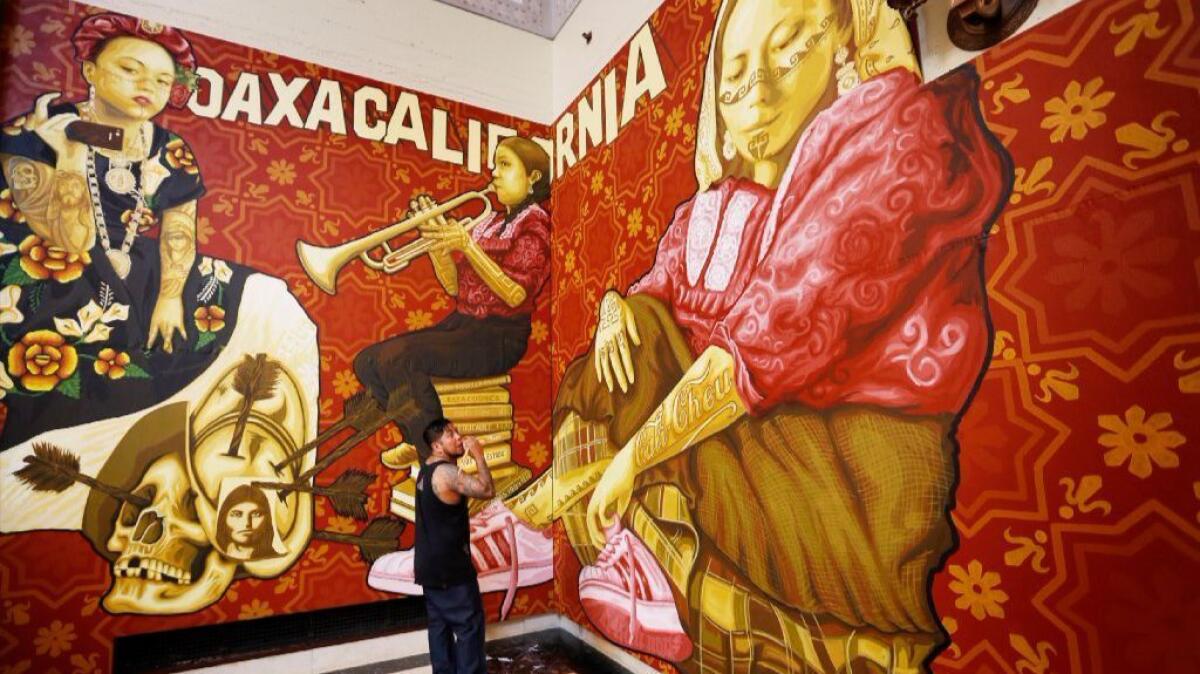
The boy is a Dreamer. A student. A graffiti tagger. A traveler. An artist.
He’s 6, maybe 7 years old, and his future is uncertain. A tattooed teardrop stains one of his cheeks, and he clutches a Sharpie and some other pens as he gazes into the distance with large brown eyes, his shorts hanging loose and low on his hips. He will in one way or another make his mark.
The image of the boy appears in a series of eight murals titled “For the Pride of Your Hometown, the Way of the Elders, and in Memory of the Forgotten” by the Oaxacan artist collective Tlacolulokos. Recently installed in the domed rotunda of the Los Angeles Public Library downtown, they’re the latest example of Latino and Latin American artists exploring the history and under-representation of the region’s indigenous peoples.
The location of the Tlacolulokos murals is a pointed statement unto itself: They hang directly below narrative murals about California’s early history created in 1933 by Dean Cornwell, whose pastel renderings show Native Americans bowing down to European colonialists. Tlacolulokos’ vibrant burgundy and gold hues scream against Cornwell’s quiet palette. The new murals say: “I have a voice. Listen up. I am here.”
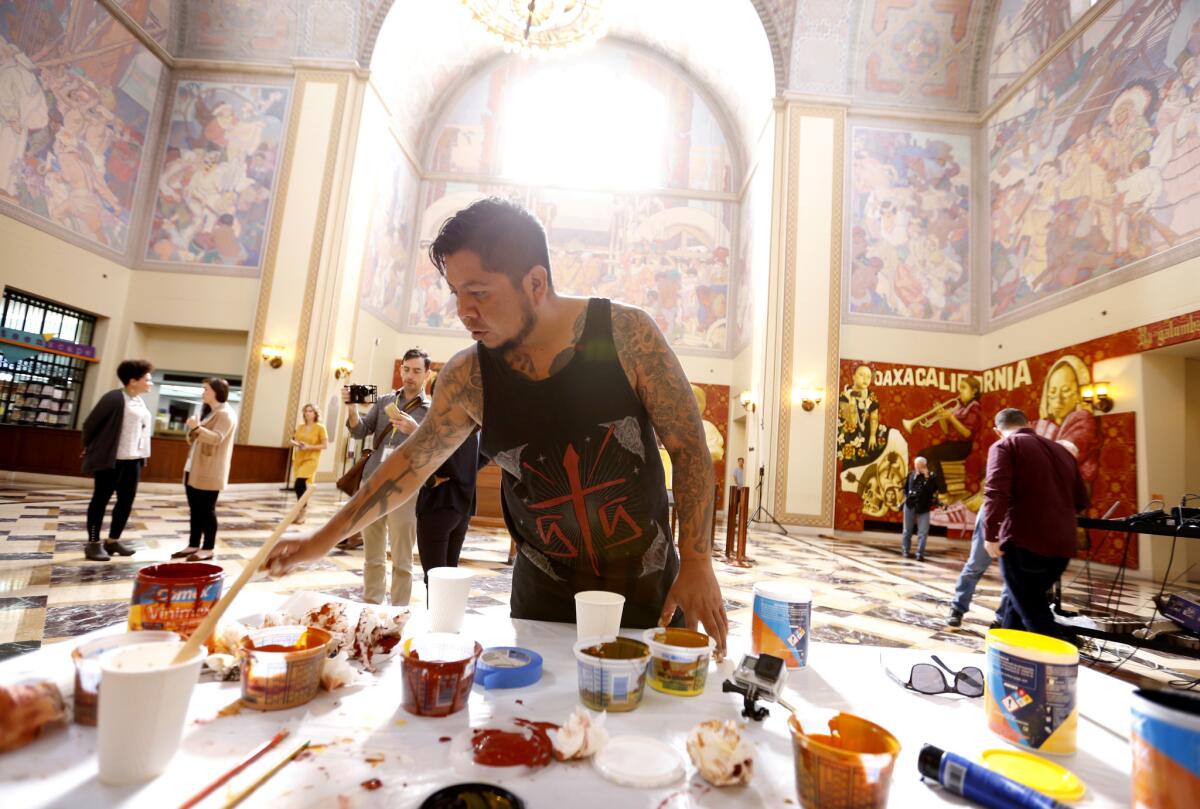
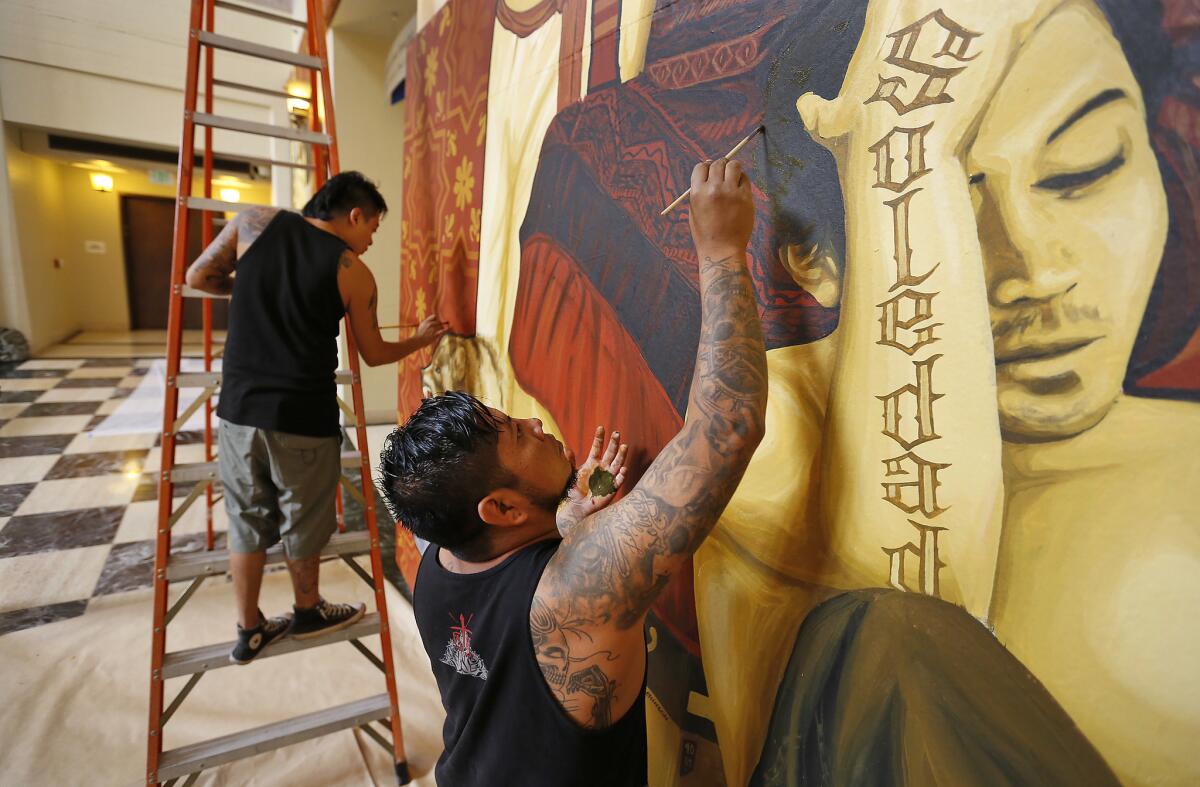
As anchors of the exhibition “Visualizing Language: Oaxaca in L.A.,” the artworks provides an alternate perspective on California history that gives voice not only to the Zapotec community but to all indigenous communities whose back stories have been overlooked.
“We thought it would be interesting to produce a contemporary history,” says exhibition curator Amanda de la Garza Mata. “Not of that period of colonialization; but the overall idea of the murals has to do with how indigenous people have the right to represent themselves and not be represented by others. This puts the indigenous migrant experience in the forefront.”
“Visualizing Language” is the Library Foundation of Los Angeles and Los Angeles Public Library’s offering for the Getty’s Pacific Standard Time: LA/LA initiative. The exhibition addresses how art and language define cultures and identity, and part of the aim is to illuminate the wider Oaxacan community in Los Angeles.
Tlacolulokos comprises Cosijoesa Cernas, 25, and Dario Canul, 31, based near Oaxaca City in Southern Mexico. They’re prolific muralists in their town of Tlacolula, where Zapotec is the native language and where their mostly black and white murals hang outside schools, houses and shops. Their murals typically depict traditional Oaxacan imagery — religious iconography, historical figures — melded with contemporary, urban scenes from Zapotec communities, locally and abroad. That could mean depictions of residents or fashions in Tlacolula or references from the worlds of street art and skateboarding.
Or it could be the Dodgers logo.
There’s a deep connection between Tlacolula and Los Angeles, which is home to an estimated 250,000 members of the Zapotec community, one of L.A.’s largest groups of indigenous Mexicans. As migrants travel back and forth between the cities, the visual imagery they’ve absorbed (tattoo designs, clothing brands, advertising logos, codified hand gestures, souvenirs from local landmarks such as the Hollywood sign) is fluid. Even though Cernas and Canul didn’t visit L.A. until 2015, their Tlacolula murals at that time were rich with L.A. imagery, such as the Dodgers lettering.
Which is partly why they were selected to create the large scale works in the L.A. library, their first U.S. commission.
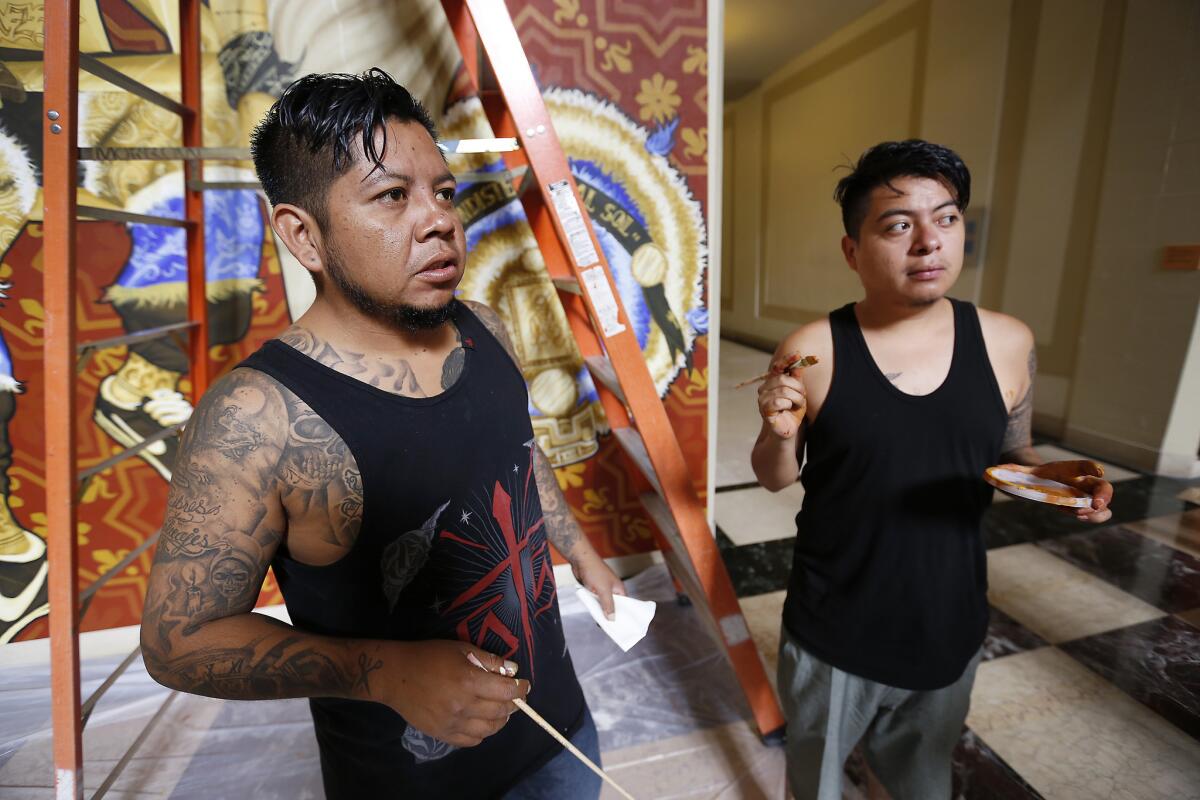
In 2015 the library foundation sent a team to Oaxaca to scout for artists who might be right for a PST exhibition addressing language, culture and identity. The team visited a solo exhibition of work by Tlacolulokos in Casa de la Ciudad, a colonial house turned cultural space in Oaxaca City.
“The most prominent piece I remember was of two women,” says exhibition producer Maureen Moore. “They were wearing garments that marked them from a particular town, but it was clear they had some connection to Los Angeles through the tattoos, the use of language — English — the style of lettering and design work. I thought, immediately: ‘Wow, these are precisely the artists we need to tell this story in the L.A. Central Library.’ ”
The library team connected with Garza Mata, an adjunct curator at Mexico City’s University Museum of Contemporary Art who had worked with Tlacolulokos before. In 2016, Cernas and Canul traveled to L.A. for a one-month residency. Funded by the Getty Foundation and the Andy Warhol Foundation for the Visual Arts, they lived near MacArthur Park and spent their days walking the streets of Koreatown and West L.A., home to robust Zapotec communities, mixing with locals and absorbing imagery.
The 13-foot-tall panels that make up the resulting project are narrative and fantastical at once, layered with pointed historical references and threaded through with Zapotec and English text. The panels are poignant, playful and sparking with humor. The murals offer a rich sense of place — not Los Angeles or Tlacolula but a hybrid urban location representing elements from both cultures. Together they’re a visual testament to indigenous identity, migration and a fused cultural identity.
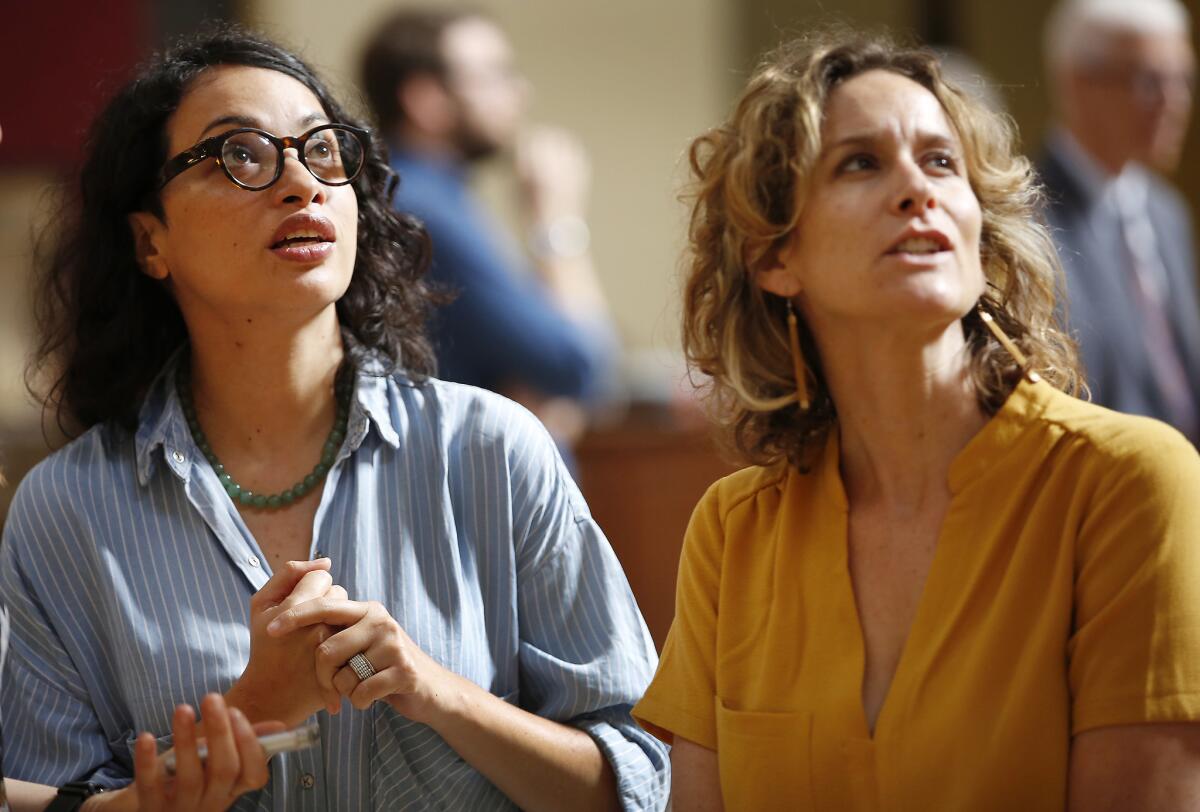
In one mural, a young woman wearing a traditional, embroidered Zapotec blouse, flowing headscarf and Dr. Martens boots reclines with a book on what’s likely a park lawn; behind her is the sister cities signpost on First and Main streets in downtown L.A., except the artists have played with the text on the signs. Instead of Koreatown and Little Tokyo, placards say “OaxakoreaTown” and “Little toklolula.” Her dense leg tattoos show a Zapotec pyramid along with bits of the downtown L.A. skyline and spindly palm trees. Despite the woman’s relaxed pose, atop the signpost the mural reads in Spanish: “A place the size of your suffering.”
“It has to do with the idea of Dreamers,” Garza Mata says. “The people who come with a dream of a better life, but actually migration is not that dream. It’s not what they envisioned because they have to struggle a lot.”
Which is why the little boy in the mural has a teardrop tattoo — not a symbol of gang violence, which the tattoo sometimes represents, but of hardship.
Another mural, with the text “Oaxacalifornia” topping it, depicts three women. One is an artist with pre-Columbian, tribal facial tattoos, a traditional Tlacolula headscarf and large Adidas sneakers. “Cali-Cheu,” in the Coca-Cola lettering, is tattooed on her arm. In Zapotec the phrase means “Where are you going?”
A female trumpet player sits atop a stack of books. At her feet, shot into a skull with an arrow, is a photograph of the Tongva woman Toypurina, who led a rebellion against the Spanish missionaries in 1785.
A third woman, in a dress with a floral pattern specific to the coast of Mexico, holds a smartphone in the air, her arms covered in tattoos.
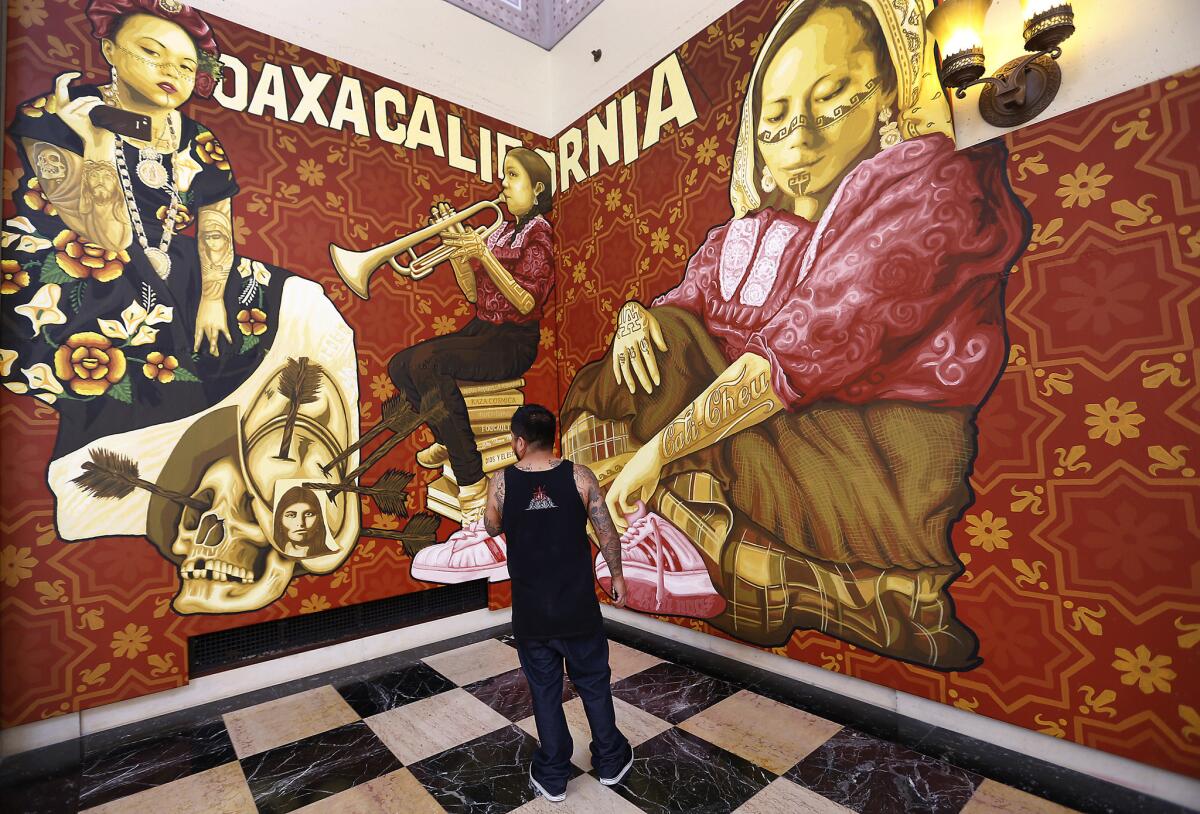
The background, unifying all eight murals, is the floor pattern of Cernas and Canul’s colonial church in Tlacolula.
“Visualizing Language” also includes a short documentary tracking the evolution of the library murals by Oaxacan filmmaker Yolanda Cruz. Branches of the library throughout the city as well as its Aloud conversation series will host events and workshops exploring themes in the exhibition.
The murals are especially timely now, Cernas says, referring to the national discussion on immigration and the
The little boy with the teardrop tattoo in the first mural, Cernas says, “represents the future for this generation. It can go either way: He could either become a gang member or a person that is part of his community and goes every day to work. It’s this open future that can go very wrong or go right.”
He adds: “With the Sharpie, I guess he’s writing his own history.”
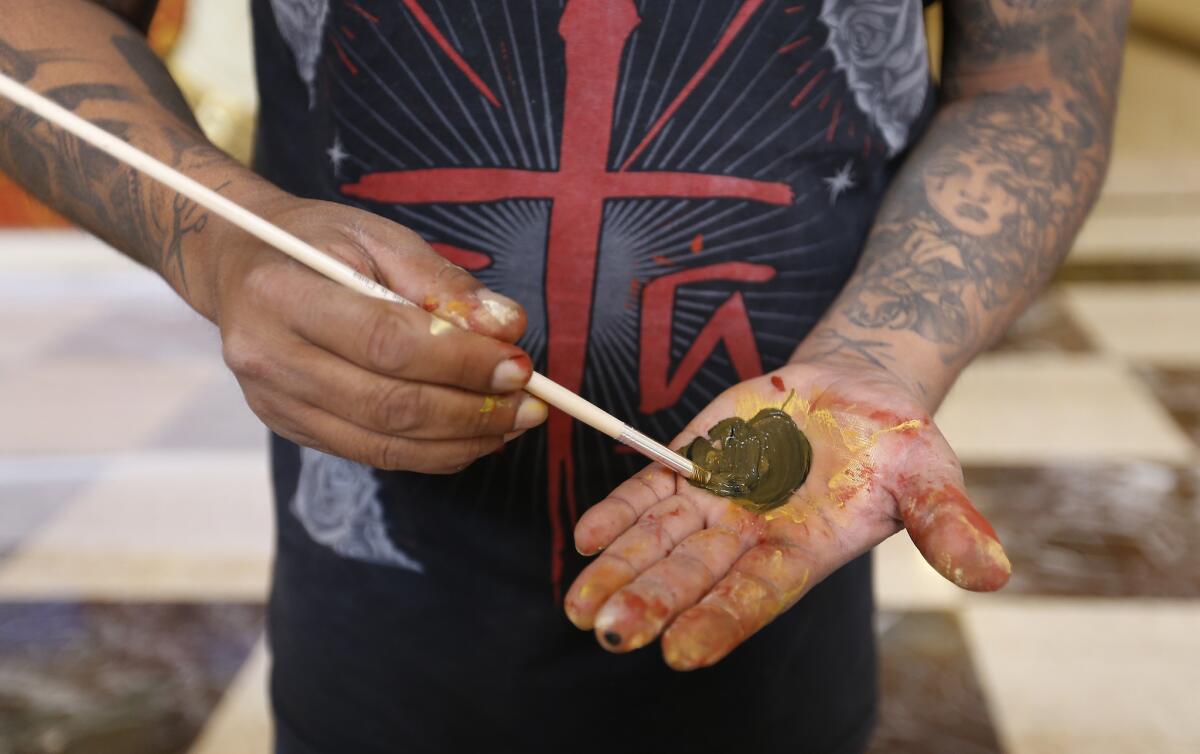
♦ ♦ ♦ ♦ ♦ ♦ ♦ ♦ ♦
‘Visualizing Language: Oaxaca in L.A.’
Where: Los Angeles Public Library, 630 W. 5th St., L.A.
When: 10 a.m.-8 p.m. Mondays-Thursdays, 9:30 a.m.-5:30 p.m. Fridays-Saturdays, 1-5 p.m. Sundays; ends Jan. 31
Admission: Free
Info: oaxaca.lfla.org
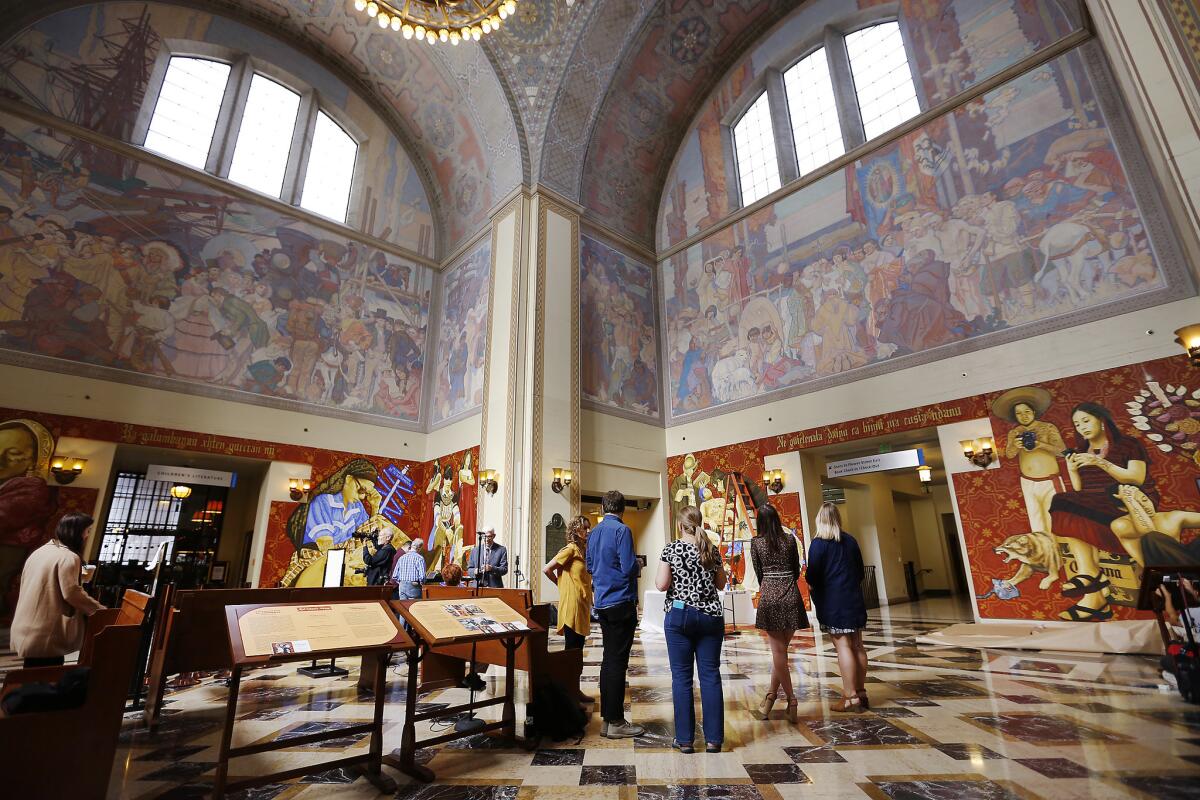
Follow me on Twitter: @debvankin
MORE STORIES:
The mystery of an artist only deepens: The remarkable drawings of Martín Ramírez
How artist Camilo Ontiveros acquired the belongings of a DACA deportee
Did you spot the egg-shaped museum cruising L.A.? Next stop: LACMA
The biggest entertainment stories
Get our big stories about Hollywood, film, television, music, arts, culture and more right in your inbox as soon as they publish.
You may occasionally receive promotional content from the Los Angeles Times.








